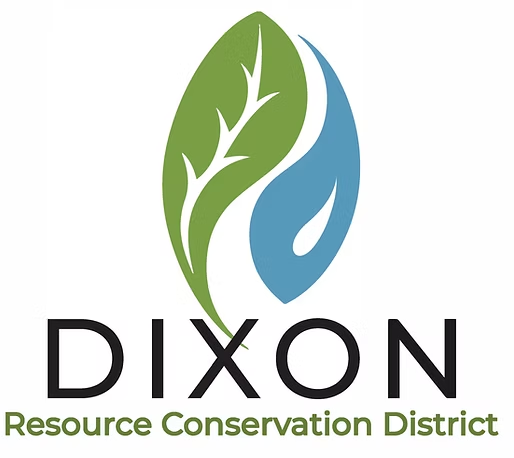Management Plans
Water Quality Coalition
Dixon/Solano Management Plans - Updated 03/06/2025
All Management Plans Submittals are available through the Regional Board. Click here for more info.
Representative Surface Water Monitoring Sites within the Dixon/Solano RCD Water Quality Coalition are sampled according to annual monitoring plans approved by the Regional Board. If the same standard is exceeded more than once in a three-year period at the same site, a Management Plan is triggered.
On June 23, 2021, there was a water column pesticide exceedance observed at the Ulatis Creek at Brown Road monitoring site. The chemical detected was a pyrethroid called lambda-cyhalothrin. A notice of the exceedance with a BMPs - best management practices - reminder has been sent to Grower's, PCAs and Commercial Applicators. On October 19, 2021, a meeting was held for all related pyrethroid users and PCAs in the area.
It is extremely important to use caution when applying these chemicals so that we protect surface water quality. In 2022 and 2023, there was zero water column exceedances at Ulatis Creek, however, on December 17, 2024 and again on May 20, 2025, there were water column exceedances at the monitoring site. For BMP, click here.
Although these exceedances have not triggered a new management plan, some type of addendum will most likely be required for our current sediment toxicity management plan. We need to be mindful of our pesticide usage particularly near waterways.
Management Plans in Progress
* Sediment Toxicity (Hyalella) & Associated Pyrethroid Products in Sediments (Ulatis) - This site had sediment toxicity exceedances in April 2018 & April 2019 and related levels of pyrethroid pesticides in the sediments. Growers represented by the Ulatis Creek at Brown Road site are exploring and implementing management practices to address the exceedances and to better understand the sources. Sediment Toxicity Data and Materials for Growers
There were zero sediment toxicity exceedances in 2020 and 2021 at the Ulatis Creek monitoring site. On April 21, 2022, there was a sediment toxicity exceedance at Ulatis Creek. In the past, there was enough information to determine the likely cause of the sediment toxicity exceedances from pyrethroid pesticides. This time, it is more difficult to pinpoint the cause of the exceedance. Although this exceedance was DNQ-detected not quantified, the exceedance extended the current management plan for an additional three years. We had zero sediment toxicity exceedances in 2023 and 2024.
Update:
On April 16, 2025, we had another DNQ exceedance of an unknown pyrethroid that extended the current management plan. We will need to wait an additional three years to submit a report to the Regional Board for approval to complete the management plan as long as we do not have any additional sediment toxicity exceedances between now and Spring 2028.
*Salinity (electrical conductivity, pH), Ecoli, Dissolved Oxygen (There continues to be frequent exceedances for these parameters at all of our sites) - Regional Board put requirements on hold for these Management Plans across the Central Valley as we work to better understand their connection to irrigated agricultural operations.
Completed Management Plans
*Nitrate Nitrite as N (Ulatis Creek) - The Regional Board deemed this management plan complete, due to the source evaluation determining the exceedances were from urban sources. Ulatis Creek had Nitrate exceedances at Ulatis Creek on January 18, 2011, December 7, 2011, February 21, 2012, and November 13, 2012. Regional Board deemed this management plan complete in March 2012.
*Malathion Detections (in 2007 only) - Since we have not had any detections since 2007, Regional Board deemed this management plan complete in May 2013.
*Diuron & Associated Algae (Selenastrum) Toxicity (Ulatis Creek) - PRODUCT LIST After intensive outreach in 2010, Ulatis Creek did not have an exceedance during 2010-2011 storm season, for the first time in 6 years. There was one exceedance January 23, 2012. The Coalition conducted a second round of outreach in the fall of 2012 and there were no exceedances during the 2012/2013 storm season. Diuron use in Solano County has decreased substantially over the last five years. Regional Board deemed these management plans complete in July 2016.
*Sediment (Hyalella) Toxicity & Associated Pyrethroid Products in Sediments (Z-Drain) - See product list. This site had repeated sediment toxicity exceedances and related levels of pyrethroid pesticides in the sediments from 2005-2012. Growers in the Z-Drain watershed spent considerable resources exploring and implementing management practices to address the exceedances and to better understand the sources. Regional Board deemed this management plan complete in August 2017.
*Chlorpyrifos (Shag Slough & Ulatis Creek) - See product list Ulatis Creek had exceedances for Chlorpyrifos on May 17, 2011, September 20, 2011, March 14, 2012, May 15, 2012 and May 19, 2015. Intensive outreach was conducted in 2011 and 2012 prior to the spring use seasons with reminders sent to alfalfa, grape and walnut growers prior to the spring season. Chlorpyrifos users, potential users and their pest control advisers received updates after the May 2015 exceedance. In July 2015 Chlorpyrifos became a restricted use material. Based on no exceedances since May 2015, Regional Board deemed this management plan complete in April 2019.
*Algae Toxicity - Selenastrum (Ulatis Creek) Under a related program's monitoring (Delta Regional Monitoring Program) unexplained (no accompanying high levels of herbicides) algal toxicity results were observed at Ulatis Creek in September 2015, February 2016, November 2016. After review of all data, the toxicity exceedances do not appear to be linked with agricultural activities, however the Regional Board still required a management plan. Dixon/Solano RCD WQ Coalition has added additional monitoring protocols that would be triggered if another algae toxicity is observed at this site, to help identify potential sources. No additional exceedances were observed through May 2021.
On November 22, 2021, we submitted a request to the Regional Board to have the management plan deemed complete. The management plan for Algae Toxicity (Selenastrum) at Ulatis Creek was determined complete by the Regional Board on January 14, 2022.
